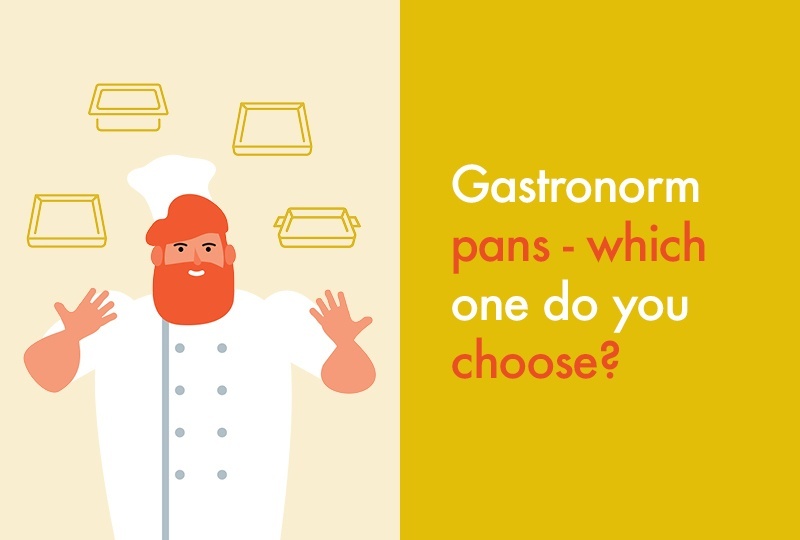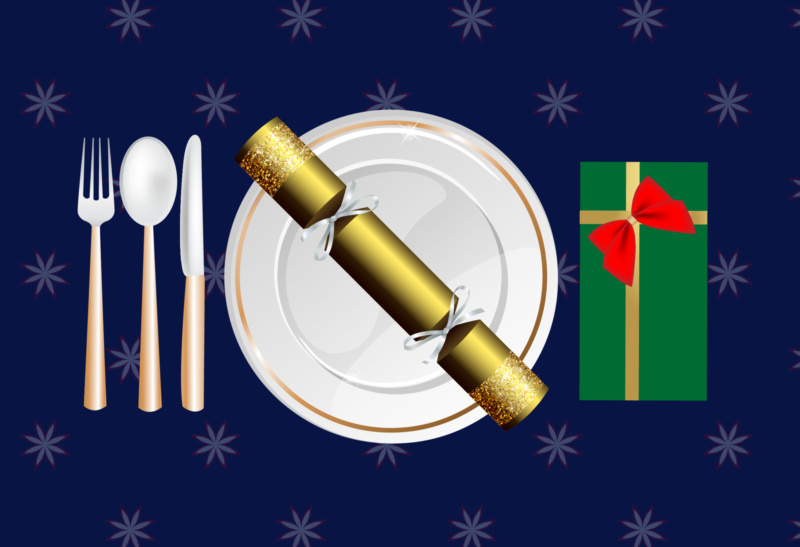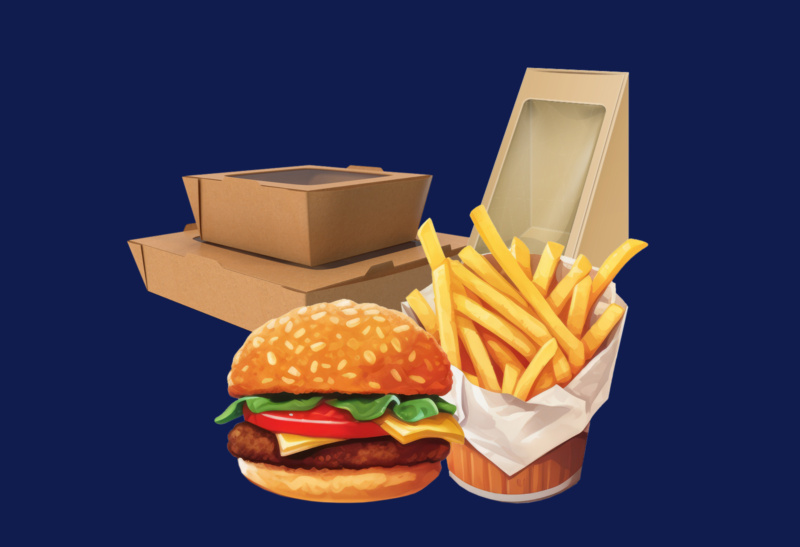The subject of Gastronorm can be a complicated area with many questions. What size do I need? Which is the best material? Is it oven or freezer proof? Will the lid be secure?
This blog aims to improve your understanding and help you make the right choice for the task in hand.
What is a Gastronorm? A brief history.
Often referred to as a GN, Gastronorm is the term for a tray, container or pan that has been made to an exact size specification for the catering industry.
The concept originated from Switzerland in 1964, gaining a European standard EN631 in 1993, which was then adopted by the British Standards Institute. This easy to follow sizing system brought a simple and measureable way to maximise oven or refrigerator space.
It also allows both manufacturers of kitchen machinery (ovens, fridges etc.) and kitchen accessories (trays and containers) to ensure compatibility and efficient use of storage capacity.
This sizing guide has evolved to be utmost in designers minds for building deli counters, hot buffet equipment, microwaves and, in fact, most catering appliances which can cook or store food.
Types of Gastronorm
Most Gastronorms, used for direct heat cooking, roasting or baking are often made from stainless steel.
They can also be perforated if they are to be used for steaming, or where airflow for even cooking is required. Refrigeration units generally use polycarbonate or polypropylene due to their excellent cold holding properties.
All of Bidfood containers are dishwasher, fridge and freezer safe.
Types of Gastronorm materials

The most common material, very strong and generally used for either cooking, keeping food warm (bain marie/chafing stands) and blast chilling.
The steel retains heat and keeps the food warm. This allows the food to be cooked and also served directly from the pan, without switching containers.
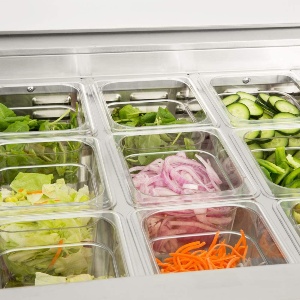
Ideally used for cold food storage and display, polycarbonate can store foods from -40°C to +99°C. Very strong, rigid and virtually unbreakable.
They are normally transparent to enable contents to be viewed easily. Although they are not suitable for cooking in ovens (direct heat), they can be used for keeping food warm (bain marie/chafing stands).
A very presentable choice for cold buffet areas, salad bars and of course, food storage.
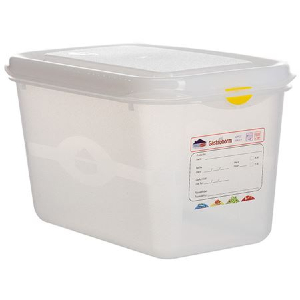
A more flexible container than polycarbonate, and most containers are opaque (slightly see through) with a temperature tolerance of -40°C to +70°C. Making them suitable for cold and warm food storage, but not ideal for food temperatures over +70°C.
Therefore, they are mostly used for back of house food storage.
Porcelain / ceramic
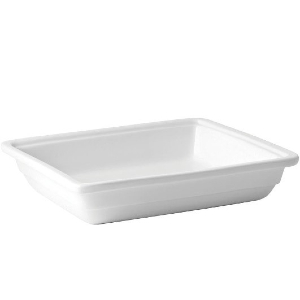
Where a more presentable dish is required, and suitable for temperatures of -20°C to +250°C, these dishes are perfect.
Available in white, these dishes can be used to cook food, display and serve without the need to decant. These can be placed directly onto a hot display product such as hot tiles in schools or restaurants.
Great for carvery restaurants. Lids not required as food is visible for serving.
Gastronorm sizing Guide
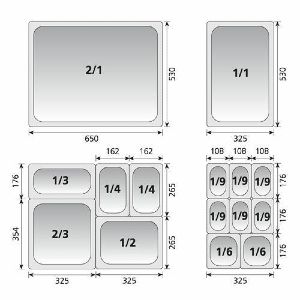
There are 9 different sizes. Regardless of material, all Gastronorm MUST conform to the following:
1/1 = 530mm x 325mm (Full)
½ = 325mm x 265mm (Half)
1/3 = 325mm x 176mm (Third)
¼ = 265mm x 163mm (Quarter)
1/6 = 176mm x 162mm (Sixth)
1/9 = 108mm x 176mm (ninth)
Other less popular sizes are:
2/1 = 650mm x 530mm (Double)
2/3 = 354mm x 325mm (two thirds)
2/4 = 530mm x 162mm (Long Half)
Standard depths of all pans are:
20mm
40mm
65mm
100mm
150mm
200mm
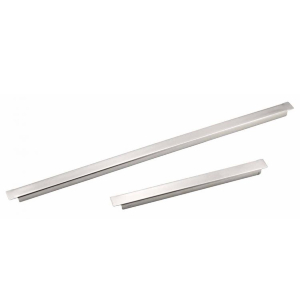
Display spacer bars, either long (530mm, code 17438) or short (325mm, code 17462), should be used as a stabiliser when displaying smaller pans.
Benefits of using gastronorm in your kitchen
Flexibility by design
The main benefit of using Gastronorm pans is that they are modular by design.
For example, you may have a 1/1 GN sized well. This could be filled with a 1/1 GN pan. Or it could be filled with 2 x ½ GN pans; or 1 x ½ GN pan and 2 x ¼ GN Pans; or even 6 x 1/6 GN pans.
Since Gastronorm pans are all based on fractions, you can flexibly combine containers together to suit your needs. A solution can normally be found for all requirements.
Things worth checking:
Will it fit: Check before ordering that the Gastronorm pan will fit into your equipment, and vice-versa. It’s important you use pans that will fit correctly. Especially check if the depth of the pan will be compatible with your equipment. E.g. most chafing stands will only take up to 100mm deep pans.
Which material: You should also check to make sure you choose a material that is suitable for the way you’ll be using them. Some materials can be used for both cooking and refrigerating, others are best for display or food storage only. Check maximum temperatures before using.
Do you need lids: Most Gastronorm pans have options for lids, in the same material, some with cut-outs for keeping ladles or other utensils organised.
INNOVATION – Flexsil-Lids.
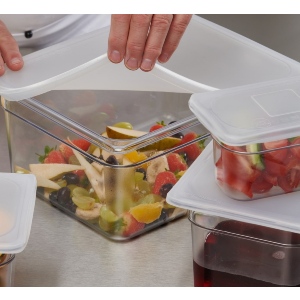
This stretchy silicone lid is available in the 6 most popular GN sizes. They will fit any material of pan, simply stretching to fit and creating a leak-proof seal.
They are oven, microwave and fridge and freezer safe, which allows the pans to be portable and stackable, locking in the contents, and creating a leak-proof container. They are also washable and reusable. (Codes 13030 – 13035). An excellent alternative to cling film!
Flexsil-Lids were bestowed the Product Innovation Award at the recent FPA awards April 2022.
Still unsure which is right for you?
There’s a huge amount of different types and sizes of containers to choose from. Visit our Gastronorm web page to explore the full range.
Or get in touch with our experienced sales team who can advise on what’s best for you and your requirements.
Hungry for more? Check out our related blogs here:
